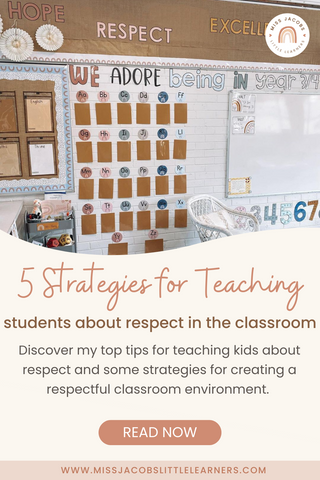
Interactive Ways to Help Students Set Goals (New Year Edition!)
It’s time to shake off the January fog. The New Year is the ultimate reset button and the perfect chance to turn that high-energy, post-holiday buzz into a focused growth...
Sometimes when kids are acting out, it’s easy to forget that they aren’t born with built-in empathy or respect for others. And while parents have the responsibility of teaching and strengthening these lessons at home, it’s also up to us as teachers to build respectful classroom environments.
When a classroom is respectful and radiates positivity, students can:
So how can we as role models teach children about respect? I’m so glad you asked.

How cute is @mrshoneyy_ classroom with classroom posters radiating positivity.
Teaching kids to treat their peers as they want to be treated is no easy task. Children learn respect from seeing it from a role model, observing how adults communicate, and through visual cues and reminders of appropriate prosocial behaviors.
With that in mind, here are some of my top tips for teaching kids about respect and some strategies for creating a respectful classroom environment.
You know that classic old saying, “you can’t be what you can’t see” – well I don’t see any reason that wouldn’t apply when teaching kids about respect. As we know, children hear observe and copy everything their parents, guardians, and teachers do (even when we don’t want them to), so modeling respectful habits is key to influencing a child’s behavior.
Having a conversation with students about what respect looks like can be an effective classroom management strategy. You might offer students a definition of respect and break it down with ideas from your class about what that looks like for them.
From their perspective, respect might look like sharing, playing games with everyone, and looking after their friends (all of which are perfect examples of respect). This will help them understand with examples that they can relate to and easily put into practice. And as a bonus, lessons in empathy, kindness, and consideration come naturally into the conversation, helping to build a class of supportive and kind classmates.
Now your students know what respect looks like, setting the tone for classroom expectations is a great next step. While you might have already done this when you first met your students, revisiting this idea with a focus on respect and allowing students to give their ideas turns the conversation into a classroom activity to establish some clear expectations for your class to follow.
Plus, by collaborating with your class to create some guidelines, students can feel a sense of pride knowing they’ve contributed to something important – making them more likely to want to follow through.
So your students understand what respect is, as a class you’ve created a list of ways to be respectful, and classroom expectations are clearly defined – now what? As teachers, we know that repeating concepts ensures the idea sticks, and having visible cues in your classroom are a great way to remind students of your expectations.
After collaborating with your students for ideas about respect, turning these ideas into a poster or door display can act as ongoing visual cues for students and are a good point of reference for when students forget – which they will.
This goes hand in hand with classroom management strategies, and I have a few resources to help. A noise or voice level display for example is a great way to cue students to lower their voices when the volume is out of control.
Look how @_kinderandcoffee uses a voice-level display from the Modern Rainbow collection with tap lights to make it super clear to students. Plus, as far as classroom decor is concerned, they look great.

Another cute tip I picked up from the Miss Jacobs Community on Instagram is to use “I show respect” as an affirmation, just like @hellomrsmoss did with her affirmation station from the Boho Vibes collection.
When kids self-regulate their behaviors and are respectful to their teachers and classmates, it is the perfect time to implement positive reinforcement and reward students when they do good – which is always WAY more enjoyable than correcting disrespectful behavior.
When young kids start to develop respect, other prosocial kinds of behavior also flourish. Children begin to understand how others feel, how their decisions affect others, and how they can be helpful, kind and supportive to their friends. It’s always really beautiful to see kids learn how their actions can benefit others and through lessons in respect, your students also have the opportunity to learn good manners, kindness, sharing and how to comfort others – it’s adorable.
The last step friends, is to give yourself some credit. Teaching kids how to understand each other's points of view is a big deal! It’s important that as a teacher, you remember how much impact you have over the people your little learners grow into. One day they will be so grateful you showed them how to be respectful and kind (ah I’m getting teary) and these valuable qualities will take them so far in life, so pat yourself on the back.
If you have any questions or put any of these strategies into practice, I'd love to hear from you. Tag me in your pics or DM me questions over on Instagram.


Teacher and Founder of Miss Jacobs Little Learners. If you’re dedicated to making a positive difference in the lives of your students – I’m here to help you.
Read MoreMiss Jacobs’ Little Teacher Community is a dedicated space for teachers just like you!
JOIN HERESign up as a Miss Jacobs BFF member today and get access to free resources!
sign up
It’s time to shake off the January fog. The New Year is the ultimate reset button and the perfect chance to turn that high-energy, post-holiday buzz into a focused growth...

Keeping a classroom running smoothly on your own is no small task, and that’s exactly where classroom jobs step in. Raise your hand if you’ve ever spent ten minutes searching...

I know, I know—you've been searching for the ultimate classroom glow-up, and I'm right here with you! One classroom theme has been consistently stealing the spotlight in the BEST way....

It’s that magical time of year when everything feels a little brighter, a little busier, and, let’s be honest, a whole lot more chaotic. Christmas classroom decor is one of the...
These high-quality, affordable classroom decor bundles feature a wide range of modern classroom themes loved by thousands...